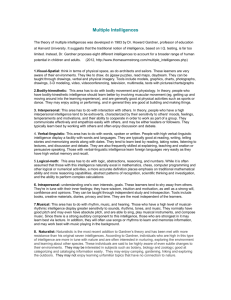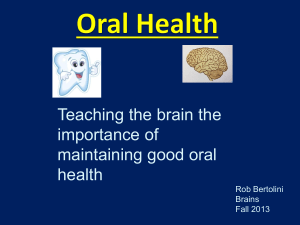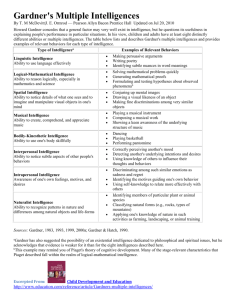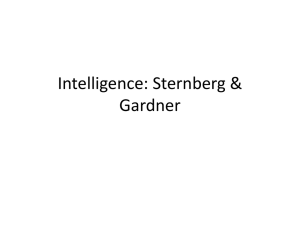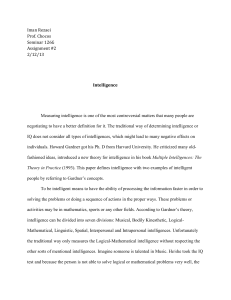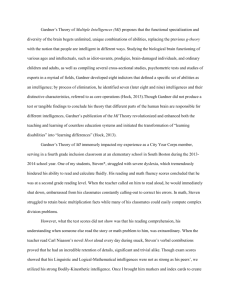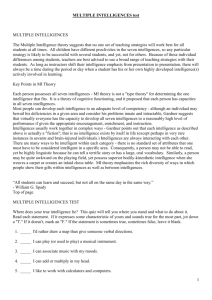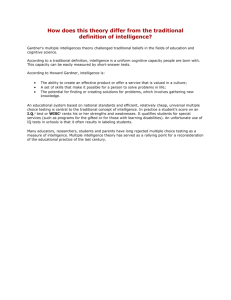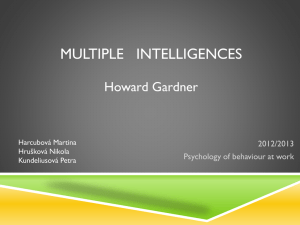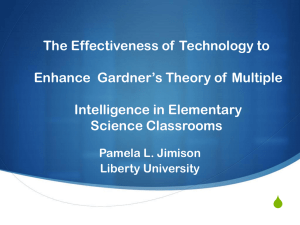Learning theories
advertisement
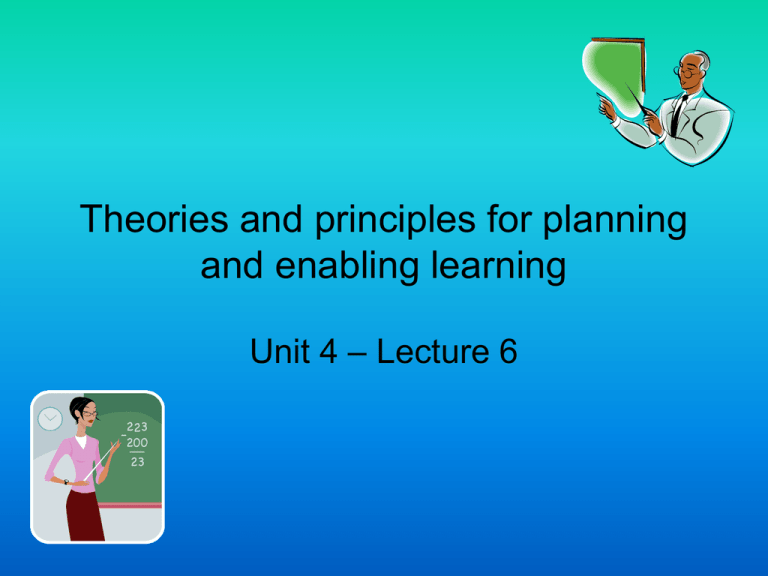
Theories and principles for planning and enabling learning Unit 4 – Lecture 6 Behaviourist Theory Intelligence is a single entity that is inherited and that human beings are born with a ‘blank slate’ and can be trained to learn anything provided that it is presented in a in appropriate way Howard Gardner (1993) – Multiple Intelligences • There exists a multitude of intelligences, quite independent of each other. • Gardner suggests most of us are strong in 3 types. • Each intelligence has its own strengths and constraints and it is very difficult to teach things that go against our strong intelligences Multiple Intelligences Theory Intelligence type Capability and perception Linguistic Words and language Logical-mathematical Logic and numbers Musical Music, sound and rhythm Bodily-kinaesthetic Body movement and control Spatial - visual Images and space Interpersonal Other people’s feelings Intrapersonal Self-awareness Multiple Intelligence Theory • Provides a pivotal indication to: – preferred learning styles – behavioural and working styles – natural strengths Gardner’s theory • Intelligence cannot be measured on a single scale. E.g. IQ test • Intelligence is a mixture of several abilities • No one is good at all of them • Yet schools, colleges, universities still perpetuate the idea that intelligence is ‘good’ and being unintelligent is ‘bad’ Gardner’s theory Each one of us has a unique and different mix of intelligences and that our abilities and potential extend far beyond traditional methods of assessment Gardner, H, (1983) ‘Frames of the mind: Theory of multiple intelligences’ Carl Rogers (1969) • According to Rogers we enter this world with no self concept and no self • All we have are: – Sensory impressions – Biological processes – Motor activities • As we grow, we differentiate ourselves from other parts of the phenomenal world to be come an ‘independent self’ Carl Rogers – ‘Freedom to Learn’ (1969) • Believed that humans have a fundamental need to realise their full potential (self-actualisation) • We use this need as a basis for evaluating our experiences in life • Those which enhance our development are seen as positive experiences • Because we all have different potentials, we evaluate experiences differently and therefore develop different sets of values Rogers on Learning • Distinguished two types of learning: – Cognitive (academic knowledge) – Experiential (applied knowledge) Experiential learning addresses the needs of the learner and is equivalent to personal growth and change Carl Rogers Believed that all human beings have a natural propensity to learn and the role of the teacher is to facilitate such learning Create the right conditions to facilitate learning • Positive climate • Clarify objectives • Organise and make available resources • Balance intellectual and emotional components of learning • Share feelings and thoughts with learners but not dominating Learning is facilitated when: • The student participates completely in the learning and has control over its nature and direction • It is primarily based on direct confrontation with practical, social, personal and research problems • Self evaluation is a principal method of assessing progress or success Significant learning • Takes place when the subject matter is relevant to personal interests of the student • Learning that is a threat to the ‘self’ (new attitudes or perspectives) are more easily assimilated when external threats are at a minimum • Learning proceeds faster when threats to the ‘self’ are low • Self initiated learning is the most lasting and pervasive Sensory learning Laird (1985) Traditional sensory stimulation theory has as its basic premise that effective learning occurs when the senses are stimulated (Laird, 1985). Sensory learning Laird’s research found that 75% of knowledge held by adults is learned through seeing. 13% through hearing and the other senses - touch, smell and taste account for 12% of what we know. Sensory learning By stimulating the senses, especially the visual sense, learning can be enhanced. However, this theory says that if multisenses are stimulated, greater learning takes place. Sensory learning Stimulation through the senses is achieved through a greater variety of colours, volume levels, strong statements, facts presented visually, use of a variety of techniques and media.
